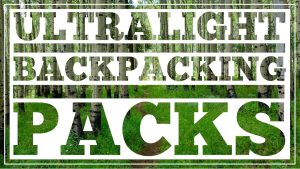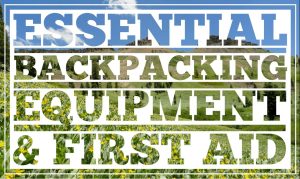Lightweight Trail Food – Episode 7
Some of the links on this page are affiliate links
Lightweight Trail Food
Trail food is a very personal choice. What you bring will greatly depend on your preferences, the nutritional value of the food, and how hard it will be to cook. Keeping your food weight down is a critical lightweight backpacking skill that will take experience to master. Hopefully these tips will help make that task a little easier.
Some backpackers choose a “food is fuel” mentality. They opt for lightweight, densely caloric foods that are easy to prepare and eat. With this mentality, ease and weight are generally more important than nutritional value.
Other hikers put a lot more effort into their food choices to build nutritional value into their backpacking meals. These hikers often cook specialized meals before their hike and may even dehydrate their own recipes. Dried fruit and vegetables make great additions to backpacking meals and simple food dehydrator will make the process very easy.
For ease and convenience, most backpackers tend to lean more towards the “food is fuel” mentality, but every hiker should choose what’s best for them.
Calories and Ounces
If you want to go lightweight with trail food, it’s important to consider how many calories per ounce are in your meals. Calories/ounce is simply a measure of the amount of energy a meal will provide for the weight that it will cost to carry.
To calculate the calories per ounce of your food choices all you have to do is tally up the calories on the back of your food package and divide by the total weight of the package.
Foods like nuts, peanut butter, chocolate, and olive oil tend to have very high calorie/ounce ratios. Foods like fresh fruit and vegetables tend to have very low calorie/ounce ratios.So you can see, if you bulk up only on foods that have high calories per ounce values, you’re not going to have a very balanced diet. The ideal range is around 120- 130 calories per ounce.
The main goal is to get as much nutrition, taste, and energy out of your food as possible, while keeping weight as low as possible. Good trail nutrition is just like good nutrition at home. You want a balance of fats,proteins, and carbohydrates while getting as much fiber, fruits, and vegetables into your diet as possible.
Easy Cooking
How difficult your food will be to cook is another very important decision for trail meals. If it’s going to take more effort than boiling water and pouring it into a bag, it’s probably too much work for your trek. So when you’re choosing dehydrated meals, make sure to choose ones with minimal cook times.
How many meals you plan to cook is another important consideration. Are you the type of backpacker that likes to have a warm breakfast? If so, you’re going to be spending a lot more time in camp in the morning and you’re also going to be burning a lot more fuel.
Backpackers that are trying to cover more miles generally like to break camp quickly and hit the trail in the morning. It’s also important to note that the quickest way to get warm in the morning is to start hiking. That’s why most lightweight backpackers only cook one meal per day – dinner.
Take time to carefully consider the total amount of food that you’ll be bringing on your trip as well. On long days of hiking, you’re going to burn a lot of calories, but you probably won’t notice the effects until the third or fourth day of your trip. After that, you’ll probably notice that you’re hungrier more often. Most thru-hikers burn 4,000-6,000 calories per day, so its important to plan meals wisely depending on how strenuous your hike is going to be.
Make sure to repackage all your trail food into plastic bags to save weight and volume. This will make your food easier to transport, organize, and cook. Also, avoid all canned foods. They tend to be low in calories, very heavy, and then you’ll have to pack out the bulky trash.
Breakfast
For trail breakfast, make sure to consider how often you’re going to want to cook. Cooking in the morning can quickly become an annoyance and many hikers get sick of instant oatmeal quickly. Also, if it’s a chilly morning, the quickest way to warm up will be to get moving. If you do want to cook in the morning, instant oatmeal, coffee, and tea are solid choices. Here are some other common trail breakfast options:
- Bars
- Pop-Tarts
- Granola
- Powdered Milk
- Breakfast Mix Packets
- Nuts
- Trail Mix
- Instant Oatmeal
- Coffee
- Tea
Snacks
Snacks are a critical part of any good trail diet. You’ll be burning lots of calories throughout your day, so eating a snack every hour or two will be a good way to keep your engine running. Keep a few snacks in your hip belt pockets for access to a quick meal while you hike. Some common quick and easy trail snacks are:
- Bars
- Trail mix
- Nuts
- Dried fruit
- Fruit leather strips
- Beef jerky
- Crackers
- Chips
- Candy
Lunch
Having a sandwich for lunch is another quick, convenient, and tasty option. Bagels and tortillas tend to hold up well on the trail and provide dense calories for your sandwich. Peanut butter, jelly, and honey are common sandwich filler options. A foil tunapacket will mix up well with a few condiment packets to make a great tuna salad sandwich. You can also bring hard meats and cheeses on the trail, which will keep well, taste great, and add lots of calories. Most hikers pair their sandwiches with snacks to round out their lunch.
Dinner
Freeze-dried backpacking dinners can be a convenient and tasty option, but they’ll also be pretty costly over time, at around $7-$10 per meal. Most supermarkets have other options that will cook quickly and cost a fraction of the price. Also, adding a tuna or chicken packet to your dinner is a great way to build extra protein and taste to your meals. Here are some of the most common dinner options for lightweight backpackers:
- Pasta Sides
- Rice Sides
- Couscous
- Dried Potatoes
- Ramen
- Dried Soups
- Stuffing
- Easy Mac
- Freeze-Dried Meals
- Chicken Packets
- Tuna Packets
Spice It Up
You can add a lot of variety and greatly enhance the taste of your trail meals with a few lightweight extras. Prepare a small condiment bag before your trip and you’ll easily be able to bump your trail meals up a notch. Here are some good options:
- Fast Food Condiment Packets – Tons of different types
- Olive Oil – calories and taste
Spice Packets – extremely lightweight taste
- Hot Sauce – duh
- Drink Flavoring Packets – add calories and flavor to your water
- Hot Coco & Cider – perfect for after dinner around a fire
Wrap Up
I’m also a big fan of taking a couple pieces of fresh fruit with me on the trail. Fresh fruits have poor calorie/ounce ratios, but I think that the taste and nutritional value is well worth the weight. Also, the rest of my bag is so light that I hardly notice a couple of extras. Apples and oranges are my favorite and I always pack out whatever is left of the core or rind.
Hopefully that gives you an idea of some of the most common long distance backpacking food choices. Food is obviously a very personal decision, so choose meals that will best fit your style. In general, try to shoot for foods with high nutritional value while keeping your overall food weight down as much as possible.
Hike light, hike smart, and have fun.
POPULAR CLEVERHIKER CONTENT
- BEST BACKPACKING TENTS
- BEST LIGHTWEIGHT BACKPACKS
- BEST SLEEPING BAGS
- TOP GEAR PICKS
- 12 BEGINNER BACKPACKING BLUNDERS
- 5 REASONS TO DITCH YOUR HIKING BOOTS
- BEST BACKPACKING STOVES
- BEST SLEEPING PADS
- BEST HAMMOCKS
- 21 TIPS FOR THE FIRST TIME THRU-HIKER
- LIGHTWEIGHT GEAR TUTORIAL VIDEOS
- ESSENTIAL TRAIL SKILLS TUTORIAL VIDEOS
MORE EPISODES IN THIS SERIES
View all





